Adequate handling, storage practices are as critical today as ever
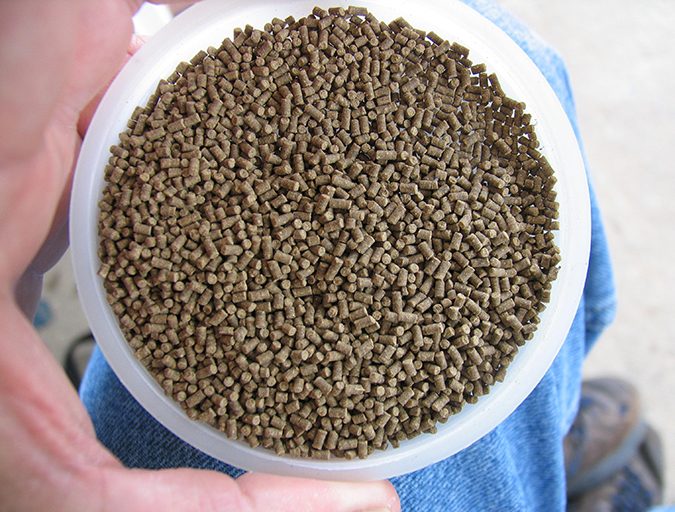
The successful management of commercial aquafeeds for shrimp requires understanding the aquatic environment and the availability and enhancement of natural food production, management of pond water and bottom, feed handling and storage, feed application method and feeding regime. The best shrimp feed in the world will yield meager results if it is not handled, stored and used properly.
Overfeeding will cause water pollution and relegate an expensive, carefully formulated and produced feed to the role of a simple fertilizer. Management of commercial aquafeeds is a sequential process, only as strong as its weakest link.
Each production facility must determine the optimal feeding rate and frequency for different commercially available feeds by testing and comparing results in growth, survival and feed efficiency for at least a few growth cycles, to account for seasonal and environmental variability.
An excellent example of the effect of feed management is that reported by Albert Tacon (1993) for FCR values resulting from testing a commercial pelleted diet in Thailand. The feed was used during a production cycle at 174 farms and reported FCR values ranged from 1:1 to 2.6:1 (Fig. 1), showing the considerable variability in results that the same feed can produce when subjected to different farm conditions and feed management practices and production methods used by different farmers.
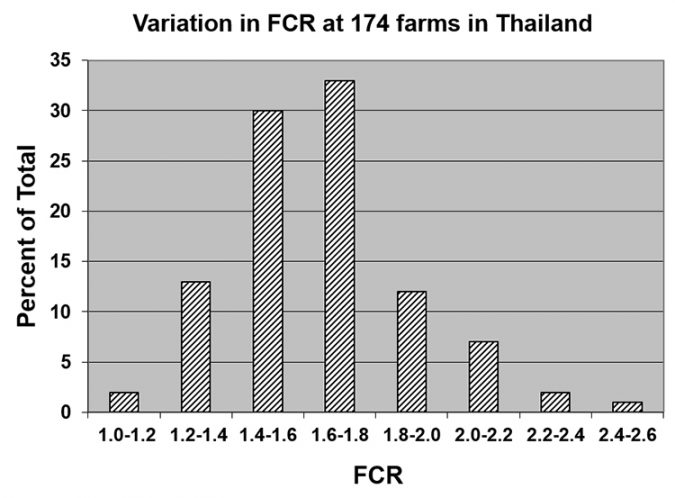
Factors that affect feed consumption in shrimp
Substantial technical information is available on shrimp-feeding behavior and interpreting this information can sometimes be difficult because some data can often seem contradictory. Looking at many of these experiments and observations, the data used can be highly dependent on a host of specific variables and circumstances that are seldom the same between studies and observations. In general, one must be careful not to interpret observations in a broader way than in the context in which they were made.
Different penaeid species have different feeding behavior, as has been reported in the literature by various authors and shrimp species, including Pacific white shrimp (Litopenaeus vannamei),
Pacific blue shrimp (L. stylirostris), black tiger shrimp (Penaeus monodon) and other species. Some species and sizes can exhibit a more aggressive feeding behavior than others, and behavior can also be affected by environmental conditions, time of day/night, availability of natural food, shrimp density and other variables. All these should be considered to better assess and understand shrimp feeding behavior for management purposes, and relevant information developed for each farm for more efficient feed management practices.
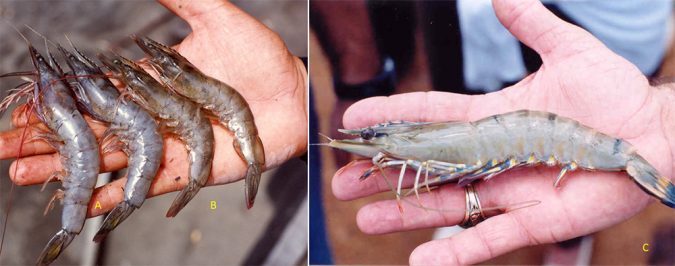
When natural food is readily available, the demand for some formulated aquafeeds can be reduced. This is typical when the biomass of stocked shrimp is low, during the first few weeks following stocking, and until a critical biomass equivalent to the natural carrying capacity of the pond (generally between 200 and 250 kg/ha, depending on several factors). After this critical biomass is reached, the importance of added formulated feed becomes increasingly important to supply the nutritional requirements of stocked shrimp.
Regarding the water quality of production systems, the most important parameters are temperature, dissolved oxygen, pH and salinity. Shrimp cannot regulate their internal temperature and the environment determines it, which affects several physiological processes, including metabolic rates and feeding.
For each parameter, animals have a broader range of tolerance and a narrower optimum range that promotes growth, survival and overall well-being. Extreme temperatures (too high or too low) and low dissolved oxygen levels will reduce feeding rates. Recommended levels of dissolved oxygen in the industry were for many years accepted at 2.5 to 3.0 ppm, but there nowadays we know that this level should be at least 4.0 ppm or higher, which can be challenging in semi-intensive culture systems without mechanical aeration.
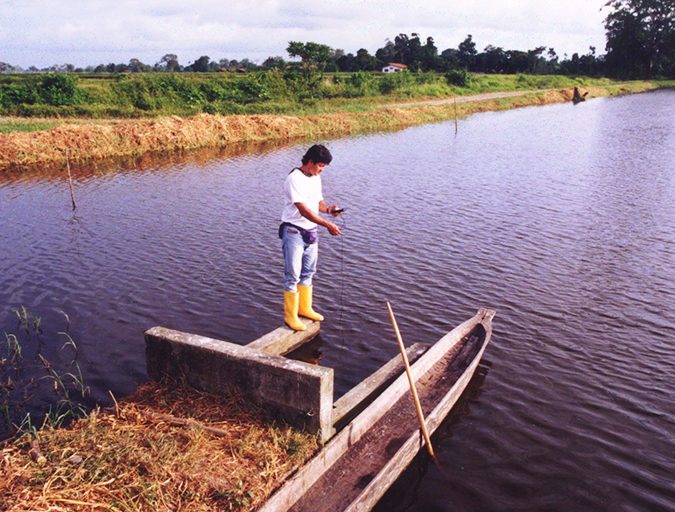
Shrimp molt periodically (days to weeks) during their lives, and this is a stressing period during which their appetite diminishes markedly. It can take two to five days for normal feeding to resume, so it is important to recognize when there is a significant reduction in feed consumption (use of feed trays is a good method) indicating high incidence of molting in a pond, and adjust feeding rates accordingly to avoid feed wastage.
The quality of commercial aquafeed used is very important. Shrimp eat to fulfill their nutritional and energy needs, and if the feed they consume does not have enough energy or nutrients, their feeding activity will increase. Feed attractability and palatability are also important factors.
Selection of shrimp commercial aquafeeds
A formulated aquafeed must meet several criteria. Each farm develops its own feed quality requirements, and there are several quality criteria used to evaluate commercial shrimp aquafeeds diets, including pellet size, uniformity of appearance, physical integrity and density, humidity, protein and lipid content, water stability, attractability and smell. The aquafeed selected must fulfill the known nutritional requirements of the targeted species. It must be fresh and free of mycotoxins and pesticides, and have low pollution potential.
The feed should have attractants and natural foods to improve feed palatability and promptly stimulate its consumption. Various attractants are commonly used in shrimp feeds to improve feed perception and detection by the animals. Attractants can improve feed perception and reduce response times (onset of feeding activity) by as much as 50 percent when compared to feeds without attractants.
The addition of enzymes and highly digestible ingredients in feed formulation increases nutrient assimilation and reduces excreted materials. Pellet size must be appropriate to shrimp size, and the feed must be sufficiently stable after immersion in water to prevent rapid deterioration, critical nutrient loss and wastage. Aquafeeds can lose nutrients rapidly after immersion, so it is important that feeds have adequate stability and attractability after immersion in water to maximize nutrient uptake by shrimp and to minimize wastage.
The physical stability and nutrient leaching of shrimp feeds are an important component of feed quality control. The physical stability of feed pellets after immersion in pond water is an environmental and financial issue, and important in the manufacture of aquafeeds, especially for shrimp. Pellet stability is the ability of a pellet to retain its physical integrity with or without disintegration and nutrient leaching while in the water and until consumed.
There are various methods to assess pellet hydrostability, but the horizontal shaking method reportedly offers more flexibility and can provide different degrees of agitation, which can be adjusted to simulate dry matter retention and nutrient leaching in actual shrimp culture systems. Testing should also consider water temperature and salinity in addition to actual pellet and water movement, to obtain consistent and accurate pellet-stability results.
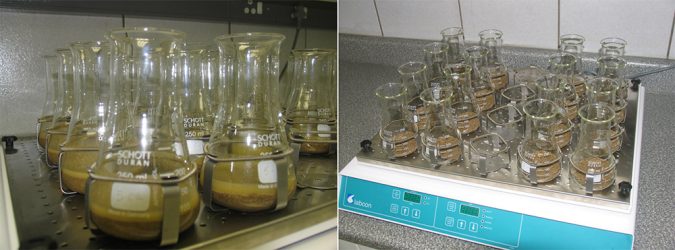
Handling and storage of shrimp aquafeeds
Feed management at a shrimp production facility should start upon arrival of a feed shipment. Adequate handling and storage of feed, and proper quality control have immediate and significant consequences for shrimp production. Poor storage and handling of feeds will result in product deterioration, reduced feed attractability and palatability, possible nutritional deficiencies and disease outbreaks, and reduced growth rates and overall production. Upon reception of a feed batch, a few randomly selected bags should be examined for physical integrity. Bags should be weighed and inspected for signs that they have been opened or broken into, and then sealed or sewn closed again.
This practice of “milking” feed bags while in transit from mill to farm can happen in many areas where a few larger farms purchase most or all of the commercial feed, and other smaller farms can then benefit by purchasing feed in the local feed black market. In addition, feed samples should be periodically collected from newly received shipments (or when using a new feed) and analyzed for proximate composition, mycotoxins, and selected pesticides if pertinent.
Aquafeeds are made of highly perishable ingredients, and it is critical to handle and store them properly until used. Most feed manufacturers provide general guidelines for handling and storage of shrimp artificial feeds. These include:
- Store feed in an area that is dry, cool and well ventilated.
- Rotate stock using older feed first, feed that has been stored the longest. Follow the FIFO “first in, first out” principle. Feed should ideally be used within the first two to four weeks after manufacturing, and should not be stored for more than two to three months.
- Feed bags should be stacked on pallets (no more than 10 bags per stack) to prevent direct contact with floor or ground, and at least 45 to 50 cm away from walls, to allow for adequate ventilation, cleaning and placement of rodent traps.
- Maintain different types of feeds separate and clearly marked. Pay particular attention to segregate medicated and non-medicated feed (and properly label the latter).
- Avoid excessive handling of feed bags, and always handle with care. Pelleted feeds are durable but not indestructible. Excessive or rough handling increases incidence of fines, thereby increasing feed losses.
- At some farms that feed several times over the course of 24 hours, the total feed ration is distributed from the warehouse to the ponds once, usually early in the morning. It is important to protect feed bags from sunlight and rain, by storing them off the ground in simple, pond-side storage sheds.
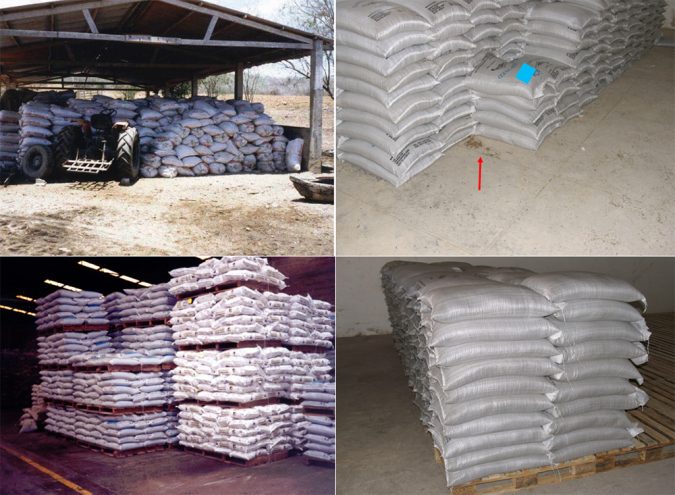
There can be various problems associated with handling and storing aquafeeds, including nutrient losses, growth of micro‑organisms, insect and rodent infestations, and rancidity. Nutrient losses occur when essential nutrients like some vitamins degrade as feed ages, particularly under storage conditions of high ambient humidity and temperature. Feed manufacturers can incorporate high levels of vitamins to allow for these losses, and also employ stabilized, breakdown‑resistant forms of vitamins. Several bacteria and mycotoxin‑producing molds can develop under warm and moist conditions prevalent in shrimp farming areas.
The negative effects resulting from inadequate feed handling and storage can be controlled by using higher levels of antioxidants and vitamins, and also anti‑fungal agents. However, additives do not a guarantee feed quality. For example, various vitamins in artificial feeds can be lost in minutes if feed bags are left uncovered under direct exposure to the sun’s ultraviolet rays. This is common during transport from feed mill to farm (e.g., open trucks), and also after feed bags have been distributed to ponds to be used later. Many insects and rodents will cause major damage to stored aquafeeds, and are also vectors for diseases and molds. To prevent entry of animals, doors and windows to storage areas should be blocked with screening materials.
The recommendation that shrimp feeds should not be stored at ambient tropical temperatures of between 28 to 31 degrees-C is probably impractical in a commercial‑scale operation due to cost constraints, but this study effectively shows the importance of adequate feed storage.
References available from author.
Author
-

Darryl E. Jory, Ph.D.
Editor Emeritus
Global Aquaculture Alliance[103,114,111,46,101,99,110,97,105,108,108,97,97,103,64,121,114,111,106,46,108,121,114,114,97,100]
Tagged With
Related Posts
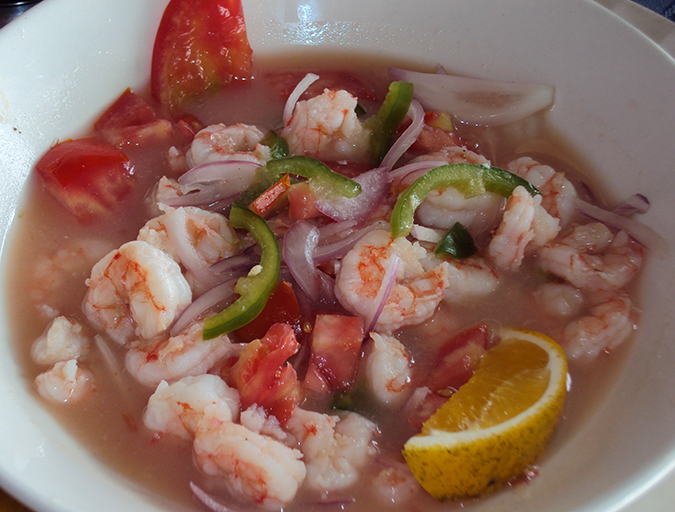
Intelligence
Facts about shrimp and cholesterol
Many people, including health-conscious consumers, are concerned about the cholesterol content of foods such as meat, eggs and dairy products. In the case of shrimp, the cholesterol story is different because a number of research studies have demonstrated that the high percentage of “good fats” in shrimp reduce the impact of cholesterol, and that a majority of people can eat shrimp as part of a balanced diet.
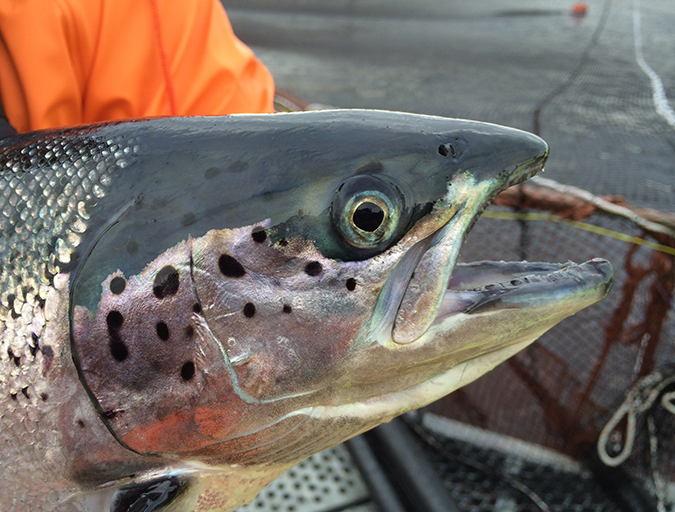
Intelligence
Survey: Salmon can gain a stronger position
With much to learn yet from the more mature chicken sector, farmed salmon has potential to become a more favored option for consumers. This study shows the potential for actions in salmon value chains to improve consumer perceptions.
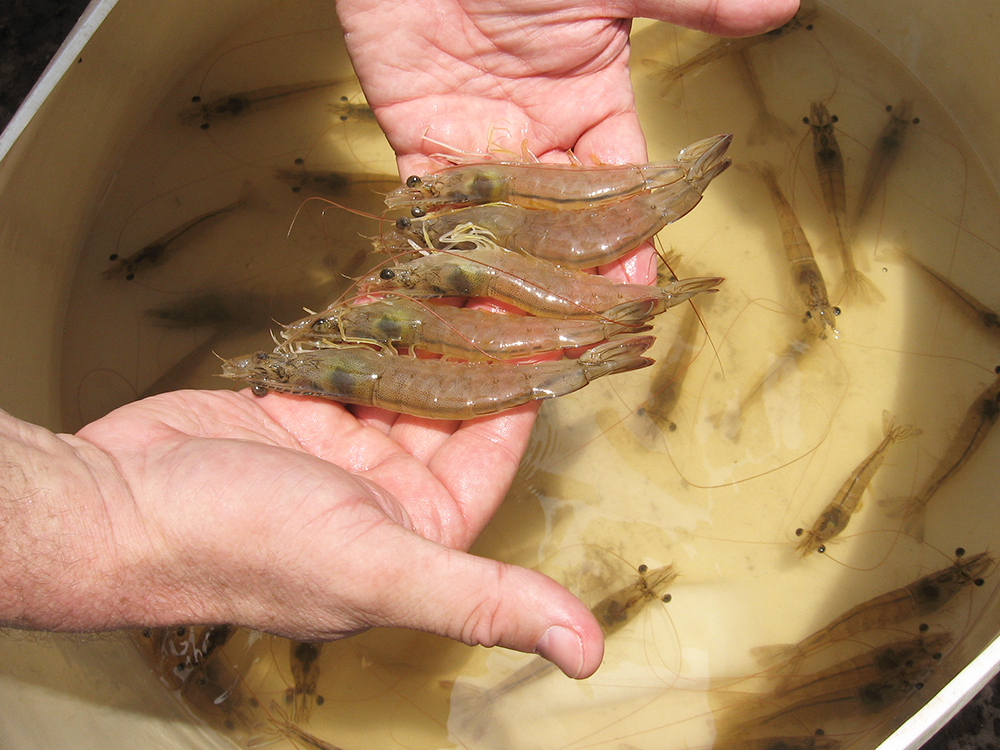
Intelligence
We can grow better shrimp, and in better ways
The recent Central American Aquaculture Symposium in Choluteca, Honduras, brought together more than 600 participants to discuss industry issues and perspectives. The focus was shrimp diseases and their impacts on production, as well as practical alternatives to face these issues and move forward.
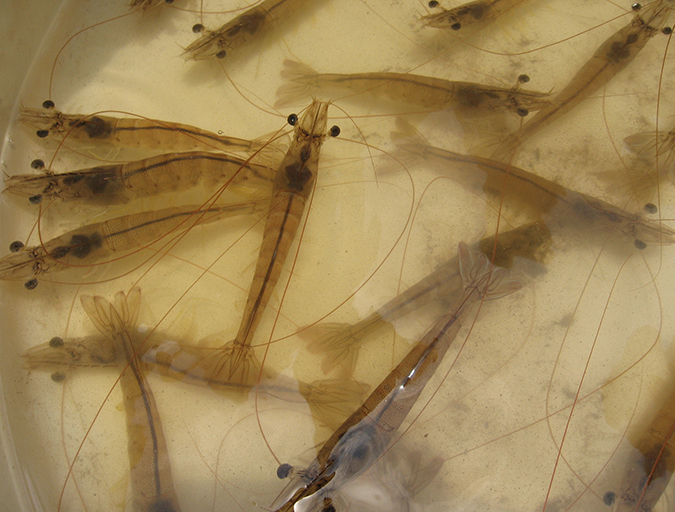
Aquafeeds
The digestibility of hydrolyzed soy protein
Studies demonstrate that hydrolyzed soy protein can be well digested and utilized by Pacific white shrimp, and that digestibility is improved through a bioprocess with the bacterium Lactobacillus spp.
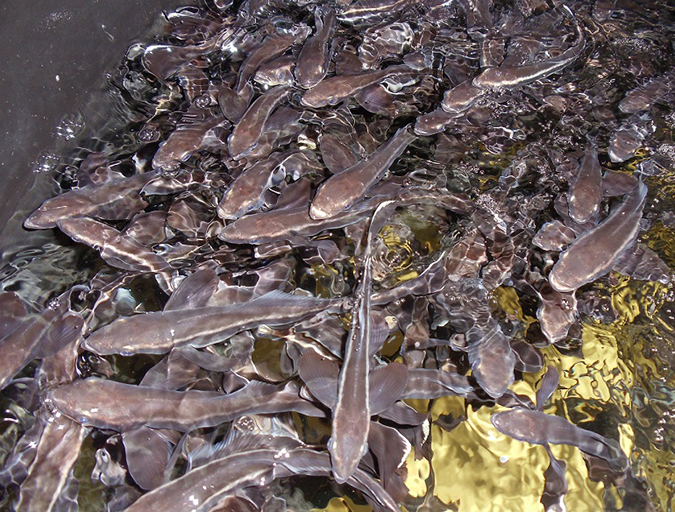
Aquafeeds
Is a fish oil-free cobia feed possible?
The availability of a cost-effective grow-out feed formulation is an ongoing bottleneck for the expansion of cobia production. Studies by the authors show that the development of an aquafeed with limited or no fish oil content is possible.

